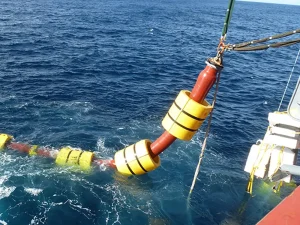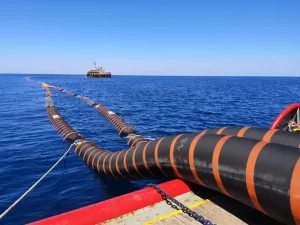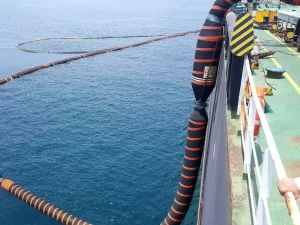Wir sehen oft, wie Öl und andere Flüssigkeiten sicher von der Mitte des Ozeans zu den Schiffen vor der Küste gelangen. Haben Sie sich jemals gefragt, wie das überhaupt möglich ist? Die Antwort liegt in der robusten Struktur von Unterwasserschläuchen. Ohne sie würde die Offshore-Öl- und -Gasindustrie nicht so reibungslos funktionieren wie sie es heute tut. Allerdings sind diese Schläuche nicht so einfach, wie sie scheinen.
Sie haben eine komplexe Konstruktion und müssen sorgfältig installiert werden. Außerdem gibt es diese Schläuche in verschiedenen Ausführungen, die jeweils für unterschiedliche Aufgaben geeignet sind. Sind Sie neu auf diesem Gebiet? Kein Grund zur Sorge! In diesem Artikel erkläre ich Ihnen alles, was Sie über U-Boot-Schläuche wissen müssen. Am Ende werden Sie genau verstehen, wie sie funktionieren und warum sie nützlich sind. Also, fangen wir an!
Übersicht der U-Boot-Schläuche

U-Boot-Schläuche, auch Unterwasserschläuche genannt, sind riesige flexible Gummirohre. Sie transportieren Öl, Gas und andere Flüssigkeiten zwischen Schiffen, Plattformen und Pipelines unter dem Meer. Deshalb werden sie auch U-Boote genannt. Diese Schläuche können schwimmen oder auf dem Meeresboden liegen, je nach den Bedürfnissen der Benutzer.
Unterwasserschläuche werden hauptsächlich in Offshore-Öl- und Gasfördergebieten eingesetzt. Diese Gebiete sind weit vom Land entfernt und umfassen Ölplattformen, Lagerschiffe und Unterwasserpipelines. U-Boot-Schläuche verbinden all diese Teile, wie z. B. Ölplattformen, mit Lagerschiffen oder Unterwasserpipelines. Auf diese Weise wird das Öl aus den Tiefseegebieten an Land befördert und für verschiedene Zwecke aufbereitet.
Darüber hinaus sind sie auch in Single-Point-Mooring-Systemen (SPM) zu finden. Bei diesem System laden und entladen Schiffe Öl, ohne im Hafen anzulegen. Diese Schläuche helfen ihnen, sich mit der schwimmenden Boje zu verbinden (Verbindung zu den Unterwasserpipelines), um Öl zwischen dem Schiff und der Pipeline zu transportieren.
Bauwesen
Wie ich bereits sagte, arbeiten U-Boot-Schläuche unter dem Meer. Sie müssen rauen Bedingungen wie hohem Druck und Salzwasser standhalten. Daher haben diese Schläuche eine robuste Konstruktion, um Sicherheit und leckagefreien Flüssigkeitstransfer zu gewährleisten. Werfen wir einen Blick auf die Zusammensetzung von U-Boot-Schläuchen.
- Innenauskleidung (Schlauch): Die Innenauskleidung ist die innerste Schicht der U-Boot-Schläuche. Dieser Teil kommt direkt mit dem Öl und anderen Flüssigkeiten in Berührung. Daher wird er in der Regel aus ölbeständigem Gummi hergestellt, damit er nicht beschädigt wird.
- Verstärkungsschichten: Um die Innenauskleidung herum befinden sich eine oder mehrere Verstärkungsschichten. Ihre Aufgabe ist es, den Schlauch vor dem Druck des Meerwassers zu schützen und ein Platzen zu verhindern. Daher sind sie mit starken Materialien wie Schnüren oder Stahldrähten ausgestattet.
- Spiralförmiger Draht: Diese käfigartige Struktur verleiht den U-Boot-Schläuchen zusätzliche Festigkeit. Diese Drähte sind in erster Linie spiralförmig um die Innenauskleidung angeordnet. Ohne diese Drähte können die Schläuche zusammenbrechen oder sich abflachen, wenn Hochdruckflüssigkeit durch die Schläuche fließt.
- Äußere Abdeckung: Die äußerste Schicht wird als Außenhülle bezeichnet. Sie schützt den gesamten Schlauch vor Sonnenlicht, UV-Strahlen und Abrieb und hält alles sicher. Sie fungiert also als die Haut der Schläuche und besteht aus starkem Gummi.
- Flansche: Dies ist ein spezielles Teil, das an U-Boot-Schläuchen angebracht ist. Flansche sind Metallringe an den Enden der Schläuche, die zur Verbindung von Schiffen oder Rohren dienen.
Arten von U-Boot-Schläuchen
U-Boot-Schläuche gibt es nicht in einer Einheitsgröße. Es gibt sie in verschiedenen Ausführungen und sie unterscheiden sich in Design, Größe und Material. Jeder Typ ist spezifisch für die verschiedenen Anforderungen der Industrie. Sehen wir uns einige der gängigen U-Boot-Schlauchtypen an.
1- Schwimmende Schläuche

Wie der Name schon sagt, schwimmen diese Schläuche auf der Wasseroberfläche. Schwimmende Schläuche bestehen aus Schaumstoff oder haben eine Luftkammer in ihrem Inneren. Diese Struktur verhindert, dass sie sinken und hilft ihnen, an der Wasseroberfläche zu bleiben. Das leichte Material bedeutet nicht, dass sie nicht stabil sind.
Ihr leichtes, aber dennoch robustes Gummi hilft diesen Schläuchen, verschiedenen rauen Bedingungen standzuhalten. Sie sind beim Single Point Mooring System zu sehen, bei dem Schiffe weit von der Küste entfernt be- und entladen werden. Bei diesem System verbinden schwimmende Schläuche ein Schiff mit den Pipelines einer Lagerplattform. So wird das Öl sicher zwischen Schiffen und Lagertanks transportiert.
2- Untergetauchte Schläuche
Unterwasserschläuche sind starke Unterwasserverbindungen. Im Gegensatz zu schwimmenden Schläuchen sinken sie auf den Meeresboden und bleiben vollständig unter Wasser. Wie Sie wissen, wird der Druck in der Tiefsee sehr hoch. Daher ist die Gefahr größer, dass Schläuche platzen. Deshalb sind Unterwasserschläuche so konstruiert, dass sie Schäden, Meeresströmungen, Felsen und Korrosion standhalten.
Diese Schläuche verbinden Offshore-Plattformen mit Unterwasser-Pipelines. Wenn zum Beispiel eine Offshore-Plattform Öl in die Pipelines leitet, wird es durch einen Unterwasserschlauch zum Lagertank befördert. Bedenken Sie, dass die Installation dieser Schläuche unter Wasser kompliziert ist. Daher haben sie oft eine permanente Verbindung zwischen Ölplattformen. Das bedeutet, dass sie nach der Installation lange Zeit im Wasser bleiben.
3- Tankwagenschienenschläuche

Es handelt sich um einen speziellen Unterwasserschlauch, der Schiffe und Ölplattformen direkt miteinander verbindet, um Öl zu transportieren. Diese Schläuche sind in der Regel an Schienensystemen wie Gleisen befestigt; deshalb werden sie "Tankerschienenschläuche" genannt." Tankerschienenschläuche findet man auf Tankschiffen auf See. Wenn ein Schiff zur Ölplattform kommt, bewegt sich dieses Haus entlang der Schiene und verbindet es mit der Plattform.
Einmal angeschlossen, fließt das Öl durch Tankerschläuche vom Tanker zum Schiff. Das Besondere an ihnen ist ihre Flexibilität, wie Gülleschläuche. Sie können sich leicht mit den Meereswellen biegen und verdrehen, ohne zu brechen, was sie sicher genug für den Einsatz in weit entfernten Tiefseegebieten macht.
4- Reduktionsschläuche
Diese Art von U-Boot-Schlauch verbindet zwei Schläuche oder Rohre unterschiedlicher Größe im Meer. Wie Sie wissen, sind bei Offshore-Ölanlagen nicht alle Teile gleich. Manchmal ist ein Ende des Systems, z. B. ein Schiff oder eine Pipeline, schmal und das andere breit. Wenn man versucht, sie direkt miteinander zu verbinden, passen sie nicht zusammen und es kommt zu Ölleckagen. An dieser Stelle kommt der reduzierte Schlauch ins Spiel.
Diese Schläuche dienen als Brücke und verbinden die beiden unterschiedlichen Größen. Ein Ende der reduzierten Schläuche ist schmal, das andere breit. Auf diese Weise verringern sie den Durchmesser von einem Ende zum anderen und werden als Reduzierschläuche bezeichnet. Wie andere Schläuche sind auch sie aus robustem Material gefertigt, um den rauen Meeresbedingungen standzuhalten.
5-teilige Schläuche
Es ist eine besondere Art von Marineschlauch der wie der Buchstabe "Y" aussieht. Dieser Schlauch beginnt mit einer großen Öffnung und teilt sich in zwei kleine Abzweigungen oder Schläuche. Auf diese Weise kann die Flüssigkeit gleichzeitig von einer Quelle zu zwei Stellen geleitet werden. In der Offshore- und Gasindustrie muss das Öl manchmal zu zwei Schiffen gleichzeitig befördert werden.
Ohne Y-geteilte Schläuche müssen Sie jedes Mal einen Schlauch anschließen und wieder anschließen, wenn Sie Öl in zwei Richtungen umfüllen wollen. Das kann Zeit und Energie kosten, und die Gefahr von Lecks und Unfällen ist größer. Mit Y-geteilten Schläuchen können Sie dagegen verschiedene Flüssigkeiten gleichzeitig an verschiedene Stellen leiten. Außerdem bestehen diese Schläuche aus robusten Materialien.
6- Doppelkarkassenschläuche
Schläuche mit doppelter Karkasse sind für Offshore-Einsätze konzipiert, bei denen die Sicherheit oberste Priorität hat. Was sie von anderen Schläuchen unterscheidet, ist ihre doppelte Schutzschicht. Im Gegensatz zu anderen Schläuchen haben sie zwei Schichten, die als "Karkasse" bezeichnet werden. Diese beiden Schichten wirken zusammen und gewährleisten doppelte Sicherheit. WIE?
Die erste oder innere Karkasse ist für den primären Flüssigkeitsstrom zuständig und steht in ständiger Wechselwirkung mit aggressiven Flüssigkeiten oder Öl. Die äußere Schicht dient jedoch als Schutzschild. Wenn die innere Karkasse reißt oder kaputt geht, ist die zweite Schicht immer da, um die Flüssigkeit zu schützen. Auf diese Weise verhindern diese Schläuche Leckagen und schützen das Meeresleben vor Verschmutzung.
Installation von U-Boot-Schläuchen
Bei der Installation der U-Boot-Schläuche werden nicht einfach zwei Enden miteinander verbunden. Es handelt sich um einen geplanten Prozess, der die ordnungsgemäße Funktion der Hochleistungsschläuche gewährleistet. Eine falsche Installation führt nicht nur zu Leckagen, sondern beschädigt auch die Schläuche. Lassen Sie uns also eintauchen und den Installationsprozess für U-Boot-Schläuche Schritt für Schritt erklären.
Schritt 1: Planung und Inspektion des Standorts
Dies ist einer der wichtigsten Schritte bei der Installation eines U-Boot-Schlauchs. Wie Sie wissen, werden diese Schläuche in der Tiefsee eingesetzt und sind unvorhersehbaren Meeresbedingungen ausgesetzt. Daher ist es sehr wichtig, den Standort zu prüfen und einige Pläne zu erstellen. Sie sollten zum Beispiel die Wassertiefe und die Beschaffenheit des Meeresbodens prüfen. Prüfen Sie auch die Windgeschwindigkeit und die Wellenhöhe, um den richtigen Zeitpunkt für die Installation zu wählen.
Schritt 2: Transport der Schläuche
Wenn die Planung abgeschlossen ist, geht es darum, den richtigen Typ auszuwählen und zu transportieren. Diese langen Schläuche sind schwer, so dass ihr sicherer Transport eine besondere Handhabung erfordert. Einige Schlauchhersteller Einrichtungen bieten Spezialfahrzeuge wie Kräne und Anhänger für den Transport eines Schlauchs an. Sobald er im Hafen angekommen ist, müssen Sie ihn zu den Offshore-Standorten liefern. Zu diesem Zweck müssen Sie spezielle Schiffe und Lastkähne für den sicheren Transport verwenden.
Schritt 3: Verlegung des Schlauchs
Nachdem der U-Boot-Schlauch seinen Bestimmungsort erreicht hat, ist es an der Zeit, ihn zu verlegen. Verlegen bedeutet, den Schlauch auf die Wasseroberfläche oder den Meeresboden zu legen, je nach Schlauchtyp. Senken Sie den Schlauch zunächst mit einem Kran oder einer Rolle ab, aber achten Sie darauf, dass er sich nicht verheddert oder geknickt wird. Wenn Sie einen schwimmenden U-Boot-Schlauch haben, halten Sie ihn mit Bojen fest. Wenn Sie jedoch einen Unterwasserschlauch verwenden, müssen Sie ihn mit Gewichten oder ferngesteuerten Fahrzeugen (ROVs) auf den Meeresboden absenken.
Schritt 4: Anschließen des Schlauchs
Nachdem der Schlauch sicher verlegt ist, wird er im nächsten Schritt an das System angeschlossen, mit dem er arbeiten soll. Bei diesen Systemen kann es sich um Ölplattformen, Tanker oder Pipelines handeln. Stellen Sie zunächst sicher, dass der Schlauch richtig ausgerichtet ist. Das bedeutet, dass das Schlauchende korrekt auf das Gerät ausgerichtet wird, an das es angeschlossen werden soll. Dann müssen Sie Flansche oder Kupplungen verwenden, um ein anderes Teil mit dem System zu verbinden. Denken Sie daran, dass diese Verbindung dicht sein muss, um einen leckagefreien Transport zu gewährleisten.
Schritt 5: Tests und abschließende Überprüfungen
Sobald der U-Boot-Schlauch sicher angeschlossen ist, muss als letzter Schritt überprüft werden, ob er ordnungsgemäß funktioniert. Dieser Schritt ist entscheidend, um einen leckagefreien Öltransport zu gewährleisten und finanzielle Verluste zu vermeiden. Pumpen Sie also zunächst Wasser mit hohem Druck durch den Schlauch. So wird der reale Zustand des Öldrucks nachgeahmt. Prüfen Sie, ob der Schlauch diesem Druck standhält und ob er leckt. Danach wird die Flexibilität des Hauses geprüft und eine visuelle Inspektion des Hauses durchgeführt. Prüfen Sie auch den Sitz und die Abnutzung der Verbindung.
Vorteile von U-Boot-Schläuchen
U-Boot-Schläuche spielen in der Offshore-Ölindustrie eine wichtige Rolle. Sie sind mehr als nur Schläuche, die den sicheren Transport von Öl aus der Tiefsee an den gewünschten Ort gewährleisten. Aber was genau macht sie so besonders? Lassen Sie uns die Antwort auf ihre Vorteile herausfinden.
1- Sicherer und zuverlässiger Transfer von Flüssigkeiten
Einer der wichtigsten Vorteile von U-Boot-Schläuchen ist ihre Fähigkeit, Flüssigkeiten sicher zu übertragen. Wie Sie wissen, kann ein kleiner Ölaustritt das Leben im Meer erheblich beeinträchtigen. Außerdem kann ein Ölaustritt auch kostspielige finanzielle Verluste verursachen. Aber U-Boot-Schläuche haben eine robuste Struktur. Sie haben mehrere Schichten, die verhindern, dass sie platzen. Daher können Sie Öl und andere Flüssigkeiten transportieren, ohne dass die Gefahr eines Lecks besteht.
2- Flexibilität und Handhabung von Bewegungen
Meereswellen und Strömungen sind zweifelsohne sehr mächtig. Sie können alles mit sich reißen und ertränken. U-Boot-Schläuche sind jedoch sehr flexibel. Im Gegensatz zu starren Schläuchen können sie sich leicht biegen und mit den Wellen bewegen, was die Gefahr von Brüchen und Schäden verringert. Selbst unter rauen Meeresbedingungen bleiben sie mit den Bojen und Schiffen verbunden, ohne dass ein riskantes Rohrsystem entsteht.
3- Einfach zu installieren und zu ersetzen
U-Boot-Schläuche sind einfacher zu installieren und zu warten als andere komplexe Offshore-Systeme. Sie erfordern nicht viel Zeit und Werkzeug für die Installation. Mit einigen Spezialwerkzeugen und der richtigen Planung können Sie sie leicht installieren. Und wenn die Schläuche beschädigt werden, können Sie sie durch neue ersetzen. Anstatt das gesamte System abzuschalten, können Sie auch den defekten Teil ersetzen.
4- Unterstützt Remote-Operationen
U-Boot-Schläuche sind sehr hilfreich für weit von der Küste entfernte Gebiete. Der Bau eines Pipelinesystems in der Tiefsee und an abgelegenen Orten ist unmöglich. Hier ermöglichen diese Schläuche den Transport von Öl und anderen Flüssigkeiten. Unternehmen können in abgelegenen Gebieten Öl fördern und lagern, um Zeit und Geld zu sparen. Die U-Boot-Schläuche helfen ihnen, die Flüssigkeit an verschiedene Orte zu transportieren.
5- Schützt die Umwelt
U-Boot-Schläuche schützen den Ozean und das Leben im Meer. Sie gewährleisten den leckagefreien Transport verschiedener Flüssigkeiten und Öle. Wenn diese Flüssigkeiten ins Meer fallen, bilden sie eine Schicht auf der Wasseroberfläche. Diese Schicht verhindert, dass Sauerstoff und Sonnenlicht eindringen können. Dies führt zum Tod von Meereslebewesen und zur Verschmutzung der Umwelt. U-Boot-Schläuche erweisen sich daher als nützlich für den Schutz unserer Umwelt.
Häufig gestellte Fragen
Wie lange können U-Boot-Schläuche halten?
Im Durchschnitt können U-Boot-Schläuche 5 bis 10 Jahre halten, je nach ihrer Verwendbarkeit. Salzwasser und hoher Druck können jedoch zu häufigem Verschleiß führen. Dies kann ihre Lebensdauer verkürzen; daher sind regelmäßige Kontrollen entscheidend, um ihre Lebensdauer zu verlängern.
Sind U-Boot-Schläuche wiederverwendbar?
Ja, Sie können einen U-Boot-Schlauch in gutem Zustand wiederverwenden. Wenn Sie jedoch Abnutzungserscheinungen feststellen, sollten Sie ihn zunächst reparieren und ihn dann vorsichtig wieder einbauen. Ich empfehle jedoch, keinen Berstschlauch zu verwenden, da er zu Leckagen führen kann.
Können U-Boot-Schläuche individuell angepasst werden?
Ja, U-Boot-Schläuche können für spezifische Bedürfnisse angepasst werden. Sie können in verschiedenen Größen, Materialien und Längen hergestellt werden. Wenn Sie zum Beispiel eine zusätzliche Schicht für zusätzlichen Schutz wünschen, können Sie den Hersteller um eine Anpassung bitten.
Schlussfolgerung
U-Boot-Schläuche spielen eine wichtige Rolle für das reibungslose Funktionieren der Offshore-Ölförderung. Es handelt sich um große Gummischläuche aus robustem Material. Ihre Mehrschichtigkeit gewährleistet die sichere und leckfreie Übertragung von Öl und anderen aggressiven Flüssigkeiten aus der Tiefsee an Land. Je nach Art und Bedarf können diese Schläuche auf der Wasseroberfläche schwimmen oder auf dem Meeresboden versinken.
In diesem Artikel habe ich alle diese Typen und ihre Spezifikationen behandelt. Außerdem erfordern diese Schläuche eine ordnungsgemäße Installation, um einen reibungslosen Transfer zu gewährleisten. Eine ordnungsgemäße Planung und Überprüfung vor und nach der Installation sind entscheidend, um Pannen zu vermeiden. Und schließlich bieten U-Boot-Schläuche mehrere Vorteile, darunter auch die Sicherheit für die Umwelt.
